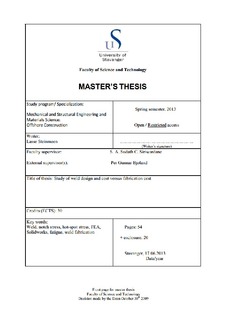| dc.description.abstract | Increasing demand in economic- and time-efficiency, in the production and design phase, has led to the question if there is a possibility to save time and money on a more detailed analysis on which weld type to use.
The thesis tries to summarize the most important factors for the different properties of weld types regarding: strength, fatigue, risk, economical and manufacturing time.
The fatigue strength of steel connections is greatly reduced by the side effect of welds, which are structural stress concentration arising from the complexity of connection made possible by welds, local geometric stress concentrations at the transition between weld and parent material, and flaws in the metal produced by welding that are currently undetectable or unavoidable.
With the use of an example from Rolls-Royce Marine, where there was some discussion around the weld design, the fatigue strength for different designs were checked with the hot-spot method and notch stress method using finite element analysis in Solidworks, a 3D CAD program used in Rolls-Royce Marine, by:
Comparing the results from the different weld types and stress assessment methods.
Including risk management to decrease probability of failure.
Check if or when necessary further analysis might be time saving, comparing the additional computing time for a more detailed analysis, versus the potential time saving on manufacturing.
The study found that in stiff structures, the hot-spot method might not manage to include the effect of stress concentration because of the weld itself. If in doubt, the notch stress method should be used.
Welds which are critical for the structures redundancy and in high risk environment should always be a full penetrating weld, to ensure fatigue cracking does not initiate at the weld root and trough the weld, which is hard to detect under an in-service inspections.
Comparing the cost of manufacturing and design analysis, the effect of cheaper weld design only comes in effect if the number of parts or components that have to be welded is large.
A suggestive flowchart for choosing weld type was made with respect to risk level and weld preparation cost versus engineering cost. | no_NO |
